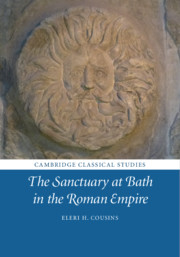Book contents
- The Sanctuary at Bath in the Roman Empire
- Cambridge Classical Studies
- The Sanctuary at Bath in the Roman Empire
- Copyright page
- Contents
- Figures
- Acknowledgements
- Abbreviations
- 1 Discovering Roman Bath
- 2 From Bath to Aquae Sulis
- 3 Experiencing Aquae Sulis
- 4 Aquae Sulis and Empire
- 5 Water from the Earth
- 6 The Local Writ Large
- Conclusion: From Aquae Sulis to Bath
- Bibliography
- Index
5 - Water from the Earth
Published online by Cambridge University Press: 07 January 2020
- The Sanctuary at Bath in the Roman Empire
- Cambridge Classical Studies
- The Sanctuary at Bath in the Roman Empire
- Copyright page
- Contents
- Figures
- Acknowledgements
- Abbreviations
- 1 Discovering Roman Bath
- 2 From Bath to Aquae Sulis
- 3 Experiencing Aquae Sulis
- 4 Aquae Sulis and Empire
- 5 Water from the Earth
- 6 The Local Writ Large
- Conclusion: From Aquae Sulis to Bath
- Bibliography
- Index
Summary
This chapter turns to our evidence for ritual practice at the site, in particular activity centred on the three hot springs. Rather than being curative in nature, the water is understood as primarily a medium for enabling ritual relinquishment of objects lost through theft or decay. The chthonic importance of the water is emphasized and linked to other aspects of ritual at the site, in particular reports from the ancient author Solinus that coal was burned on Sulis’s altars. Depositional practice at Aquae Sulis is compared to other watery sites in Britain and Gaul, and the Bath corpus of ‘curse tablets’ is placed into a wider context, with the sanctuary at Uley serving as a particularly important counterpoint to Bath.
- Type
- Chapter
- Information
- The Sanctuary at Bath in the Roman Empire , pp. 110 - 149Publisher: Cambridge University PressPrint publication year: 2020

